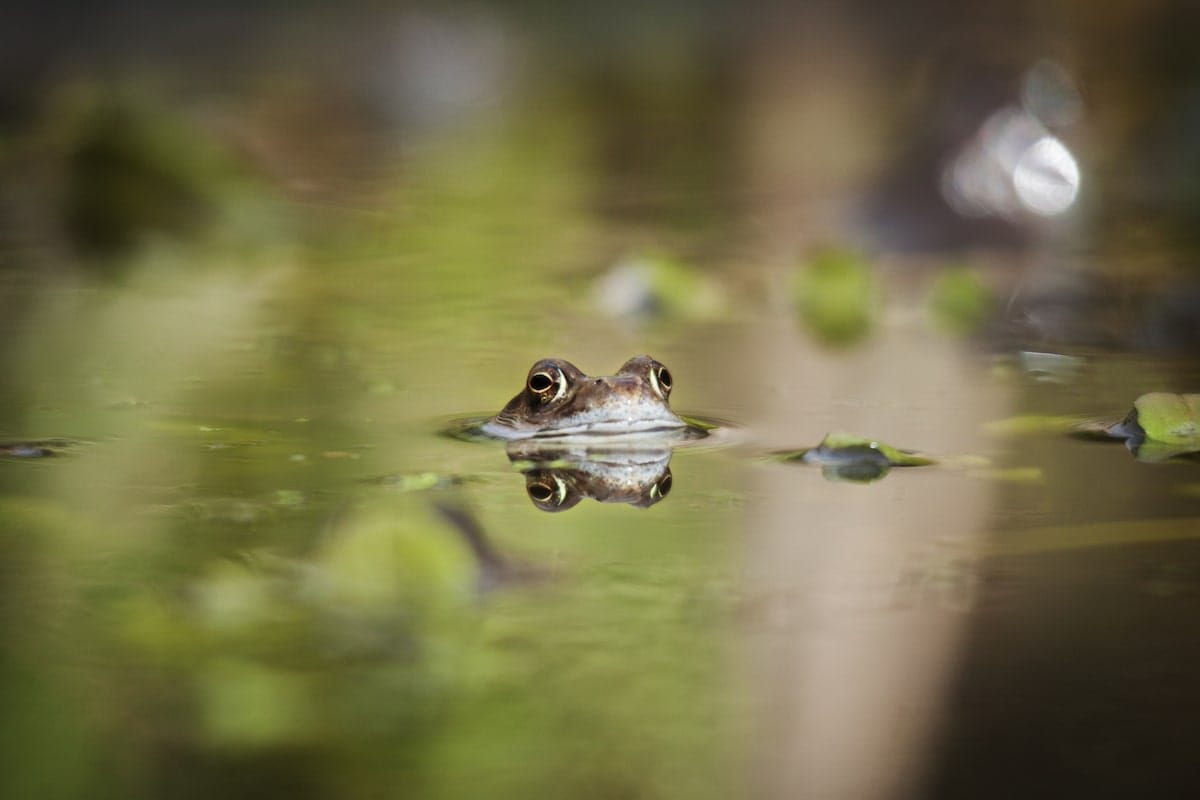Frogs, those charming amphibians that grace our ponds and gardens, seem equally at home hopping on land and swimming in water. This begs the question: Can frogs breathe underwater? The answer is a bit more nuanced than a simple yes or no. Let’s dive into the fascinating world of frog respiration to uncover the truth.
How Frogs Breathe: A Dual System
Frogs are masters of adaptation, equipped with a unique respiratory system that allows them to thrive in both aquatic and terrestrial environments. Unlike humans, who rely solely on lungs for breathing, frogs utilize two primary methods:
1. Cutaneous Respiration: Breathing Through Skin
Imagine breathing through your skin! For frogs, this isn’t science fiction—it’s a reality. Their skin, thin, porous, and constantly moist, acts as a secondary respiratory organ, allowing them to absorb oxygen directly from the water. This process, known as cutaneous respiration, is particularly crucial for underwater survival.
To facilitate cutaneous respiration, a frog’s skin must remain damp. Mucus glands distributed across their bodies secrete a slimy substance that not only keeps their skin moist but also aids in oxygen absorption.
2. Pulmonary Respiration: The Role of Lungs
While their skin plays a vital role in underwater breathing, adult frogs also possess lungs, similar to those found in mammals. However, their lungs serve a slightly different purpose. Frogs primarily utilize their lungs for breathing air when on land or when their oxygen demands exceed what their skin can absorb.
Unlike mammals, frogs lack a diaphragm, the muscle responsible for expanding and contracting the chest cavity to facilitate breathing. Instead, they rely on their throat muscles to create pressure changes that draw air into and expel it from their lungs.
So, Can Frogs Live Underwater Permanently?
Despite their ability to breathe through their skin, most frogs cannot live underwater permanently. The amount of oxygen they can absorb through cutaneous respiration is limited and depends on factors such as water temperature and the oxygen levels present in the water.
Think of it this way: cutaneous respiration provides enough oxygen for a frog to survive underwater, but not necessarily to thrive. When a frog is active—swimming, hunting, or escaping predators—its oxygen demands increase. In these situations, they rely on their lungs to supplement the oxygen absorbed through their skin.
The Drowning Risk: Why Frogs Need to Surface
This reliance on lungs for supplemental oxygen explains why even frogs that spend a significant amount of time underwater need to surface regularly. Prolonged submersion, especially in warm, stagnant water with low dissolved oxygen levels, can lead to drowning.
Variations Among Frog Species: From Semi-Aquatic to Fully Aquatic
While most frogs are classified as semi-aquatic, comfortably navigating both land and water, some species have evolved to become fully aquatic. These remarkable creatures have adaptations that allow them to spend their entire lives submerged.
One such adaptation is the retention of gills, the respiratory organs used by fish and tadpoles (frog larvae). While most frogs lose their gills during metamorphosis, the process of transforming from a tadpole into an adult frog, some fully aquatic species retain them or possess underdeveloped lungs, relying primarily on gill and skin respiration for oxygen.
The African Clawed Frog and the Titicaca Water Frog are prime examples of fully aquatic frogs. These species have adapted to their watery environments over millennia, showcasing the incredible diversity and evolutionary ingenuity within the amphibian world.
The Factors Affecting Underwater Breathing: It’s Not Just About Lungs
A frog’s ability to stay submerged varies significantly depending on a complex interplay of factors:
- Species: As discussed, some species are fully aquatic, while others are semi-aquatic, dictating their underwater time limits.
- Water Temperature: Colder water holds more dissolved oxygen than warmer water, allowing frogs to stay submerged for longer periods in colder temperatures.
- Activity Level: Just like us, a frog that’s engaged in vigorous activity will consume oxygen at a faster rate, limiting its underwater time.
- Water Conditions: The presence of pollutants or low oxygen levels in the water can significantly reduce a frog’s ability to breathe underwater, forcing them to surface more frequently or risk drowning.
The Importance of Understanding Frog Respiration for Conservation
As we delve deeper into the intricacies of frog respiration, we gain a greater appreciation for their remarkable adaptations and the delicate balance of their dual existence. This understanding is crucial, particularly in the face of global climate change and habitat degradation.
Rising water temperatures, pollution, and habitat loss pose significant threats to frog populations worldwide, impacting their ability to breathe both underwater and on land. By recognizing the importance of clean water, suitable habitat, and the factors influencing their respiratory processes, we can contribute to conservation efforts aimed at protecting these fascinating and ecologically vital creatures.
People’s Statements:
- “They just breathe through their skin! How long can frogs breathe underwater? Frogs are amphibians and not fully aquatic animals, they still breathe through their skin, An adult frog can typically hold its breath anywhere between 4 to 7 hours.”
- “Although semi-aquatic frogs can stay underwater for several hours at a time, and fully aquatic frogs live underwater, no species of frogs can survive without oxygen. If, for example, you had a fully aquatic frog in an aquarium and never changed or aerated the water, your frog might die due to lack of oxygen.”
Do you know if can alligators and crocodiles mate? Or, do can axolotls live on land? Discover the engaging answers to both these questions from credentialed animal experts.
- Unraveling Einstein’s Legacy: Who Inherited His Genius? - July 14, 2025
- Unlock Einstein’s Family Tree: Bernhard Caesar & Untold Stories - July 14, 2025
- Unveiling Bernhard Caesar Einstein: His Life & Albert Einstein’s Legacy - July 14, 2025

















2 thoughts on “Can Frogs Breathe Underwater? Decoding the Truth About Amphibian Respiration”
Comments are closed.